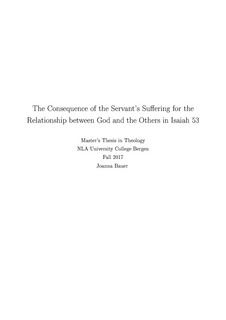| dc.description.abstract | This thesis studies the relation between the servant's suffering and the others' reconciliation
with God as it is presented in Isaiah 53.
Commonly, reconciliation in Isaiah 53 is suggested to be by the servant's message
causing contrition or faith, or by his suffering being atoning. Reconciliation by message is
commonly based on interpreting the servant as a prophet. Reconciliation by atonement
is commonly based on expressions in Isaiah 53 which can be related to cultic expiation of
sin.
The thesis is based on a thorough study of the text of Isaiah 53. This study suggests
uncommon answers to textcritical questions. It also suggests uncommon translations of
some verses of Isaiah 53. Further, it suggests that Isaiah 53 is intentionally ambiguous,
both concerning the identity of the servant, and concerning reconciliation.
Isaiah 53 depicts the servant both as in need of reconciliation and as righteous, and
thus not in need of reconciliation. This contradiction can be resolved by an ambiguous
identity of the servant. Isaiah 53 depicts the servant ambiguously both as the servant
Israel, in need of reconciliation, and as a righteous servant, who reconciles Israel.
Isaiah 53 states reconciliation by chastisement and insight, and by transfer of the
burden of sin. Isaiah 53 also alludes to cultic expiation of sin. Concerning chastisement,
the servant Israel is chastised by being sent into exile. This chastisement fosters the
servant's insight and resulting righteous conduct, and thereby, the servant's peace with
God. Concerning transfer of the burden of sin, Isaiah 53 states that the we-group's and
the many's burden of sin, that is, the guilt incurred by sin and the punishment for this
guilt, is transferred to the righteous servant. By this transfer, the others are freed from
their guilt and thus reconciled. Concerning cultic expiation of sin, Isaiah 53 clearly alludes
to both the Day of Atonement and the liability offering, but does not decisively depict
the servant as scapegoat or liability offering.
Reconciliation by transfer of the burden of sin amounts to vicarious suffering. The
concept of vicarious suffering has been criticized for being unique to the Old Testament.
However, vicarious substitution is a concept commonly found in the Old Testament. Vicarious
substitution may have inspired the concept of vicarious suffering as a specific
application. | nb_NO |
